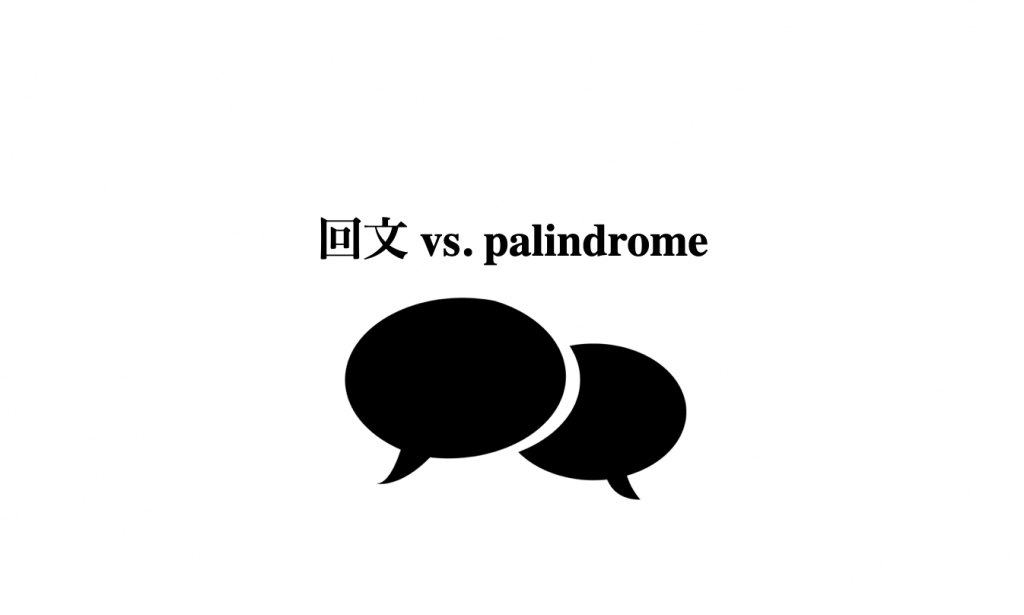
回文 vs. palindrome
回文 vs. palindrome
回文と palindrome の異同とは?
Do you happen to know what a ‘palindrome’ means? It’s called「回文」in Japanese. Yes:
e.g., radar / Madam, I’m Adam. / Sir, I’m Iris. / Nurses run. ,etc. from English
「たけやぶやけた」「イラクの妃の位」「かつ節の私物化」「桜取るのにパパに乗ると楽さ」, etc. from Japanese.
Actually, there is an essential and fundamental difference between English cases and Japanese ones. Did you notice?
In English, palindromes are defined in terms of ‘letters,’ not ‘pronunciation’ proper.
→
「radar」
←
(differs in ‘pronunciation,’ despite the sameness of ‘letters.’ See?)
On the other hand, in Japanese cases,
a. firstly, they are based on ‘pronunciation,’
b. but additionally, they exhibit a unique feature as well.
Concerning b, they are specified not by simple ‘consonants’(子音)or ‘vowels’(母音), but via the ‘units of mora’「拍」(basically ‘(consonant) + vowel units’「あ」「い」「か」「き」and so on).
See the following:
When on ‘拍’-based:
「トマト」
→
「ト.マ.ト」
←
(the same)(=回文)
But!!!!!! when on ‘consonants/vowels’-based:
「トマト」
→
「t.o.m.a.t.o」
←(‘o.t.a.m.o.t’!!!!!!)(≠ 回文!)
And!!!!!! when on ‘consonants/vowels’-based:
「赤坂」
→
「a.k.a.s.a.k.a」
←(a.k.a.s.a.k.a 赤坂!!!!!!)(―quasi-回文 phonetically, although not identified as usual 回文)
A bit difficult? Don’t worry. A careful review of the above will let you get the picture. :)
Anyway, the spirit of studying something is to ENJOY it, and the best way is to DO IT BY YOURSELF! So, why don’t you create your own「回文」!
As a demonstration, I will show you my work of「回文」: I hit upon it awaking from sleep one morning.
(あ~ら、あなたもモンスター?)「あたすんもモンスター」
→
「あたすんもモンスター」
←(=回文)
:) :) :).
以上、today’s edutainment でした ^^j。Have fun and a nice day, buddies!
Do you happen to know what a ‘palindrome’ means? It’s called「回文」in Japanese. Yes:
e.g., radar / Madam, I’m Adam. / Sir, I’m Iris. / Nurses run. ,etc. from English
「たけやぶやけた」「イラクの妃の位」「かつ節の私物化」「桜取るのにパパに乗ると楽さ」, etc. from Japanese.
Actually, there is an essential and fundamental difference between English cases and Japanese ones. Did you notice?
In English, palindromes are defined in terms of ‘letters,’ not ‘pronunciation’ proper.
→
「radar」
←
(differs in ‘pronunciation,’ despite the sameness of ‘letters.’ See?)
On the other hand, in Japanese cases,
a. firstly, they are based on ‘pronunciation,’
b. but additionally, they exhibit a unique feature as well.
Concerning b, they are specified not by simple ‘consonants’(子音)or ‘vowels’(母音), but via the ‘units of mora’「拍」(basically ‘(consonant) + vowel units’「あ」「い」「か」「き」and so on).
See the following:
When on ‘拍’-based:
「トマト」
→
「ト.マ.ト」
←
(the same)(=回文)
But!!!!!! when on ‘consonants/vowels’-based:
「トマト」
→
「t.o.m.a.t.o」
←(‘o.t.a.m.o.t’!!!!!!)(≠ 回文!)
And!!!!!! when on ‘consonants/vowels’-based:
「赤坂」
→
「a.k.a.s.a.k.a」
←(a.k.a.s.a.k.a 赤坂!!!!!!)(―quasi-回文 phonetically, although not identified as usual 回文)
A bit difficult? Don’t worry. A careful review of the above will let you get the picture. :)
Anyway, the spirit of studying something is to ENJOY it, and the best way is to DO IT BY YOURSELF! So, why don’t you create your own「回文」!
As a demonstration, I will show you my work of「回文」: I hit upon it awaking from sleep one morning.
(あ~ら、あなたもモンスター?)「あたすんもモンスター」
→
「あたすんもモンスター」
←(=回文)
:) :) :).
以上、today’s edutainment でした ^^j。Have fun and a nice day, buddies!
アカウントを作成 して、もっと沢山の記事を読みませんか?
この記事が気に入ったら 章太郎 さんを応援しませんか?
メッセージを添えてチップを送ることができます。

この記事にコメントをしてみませんか?